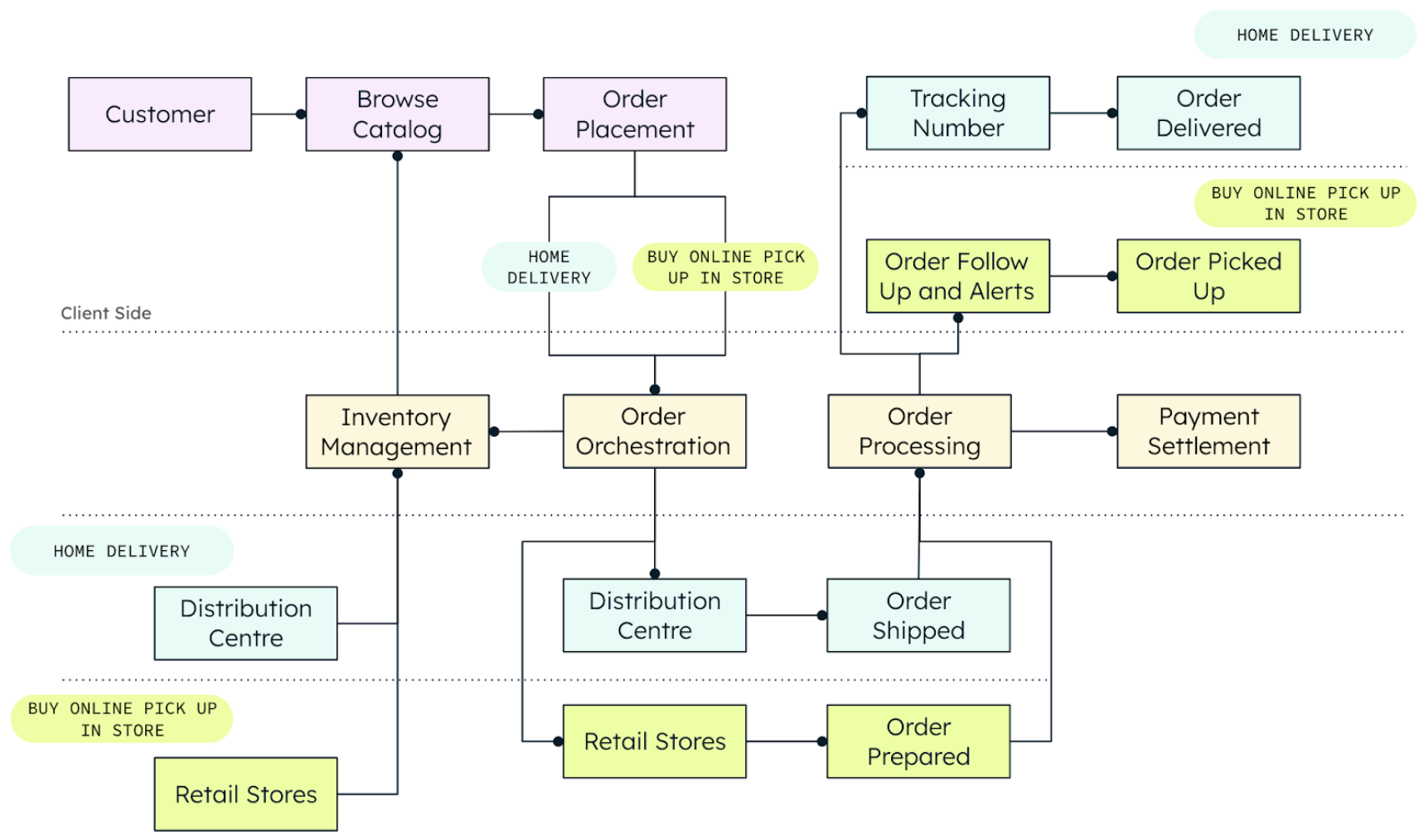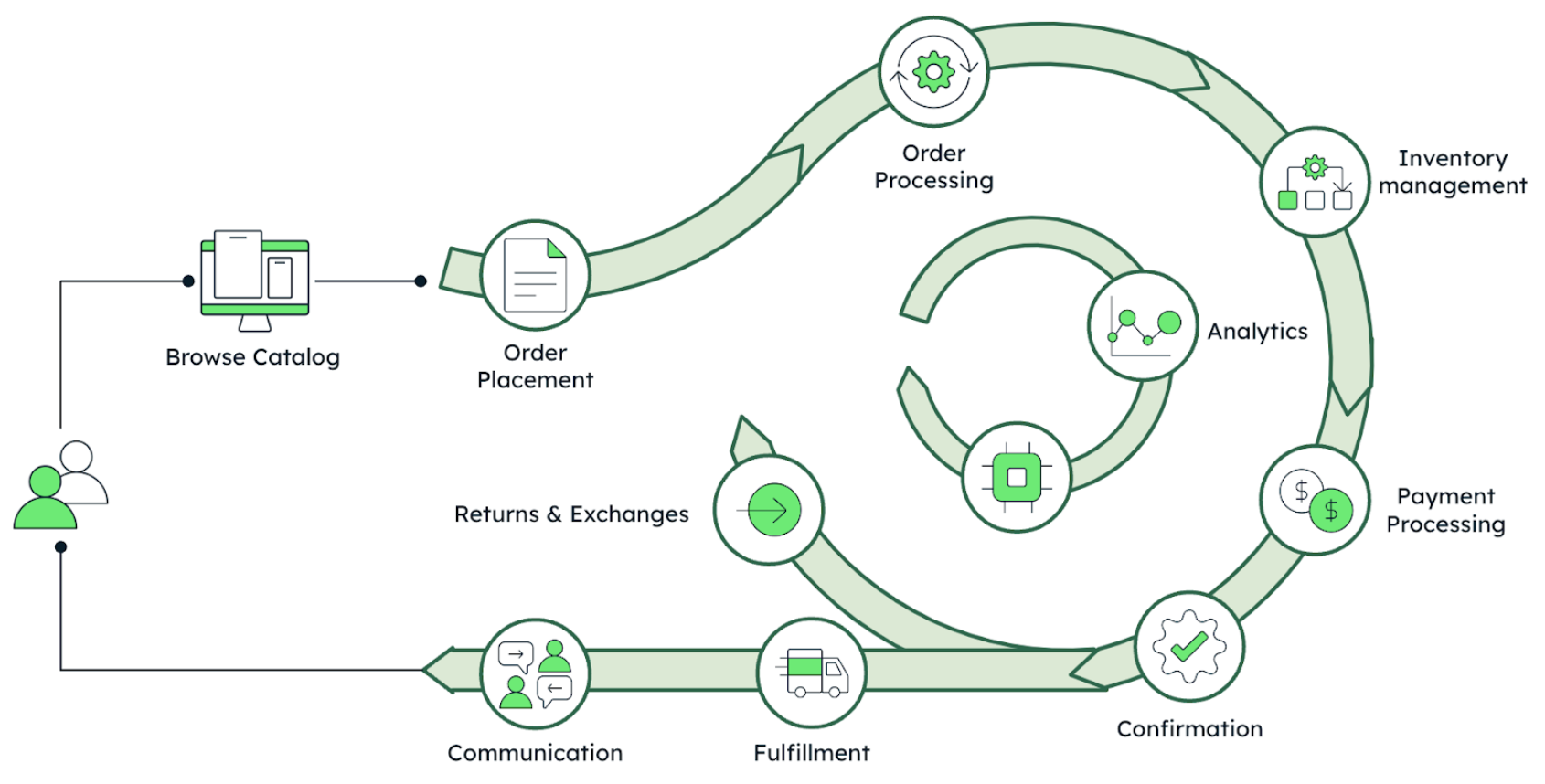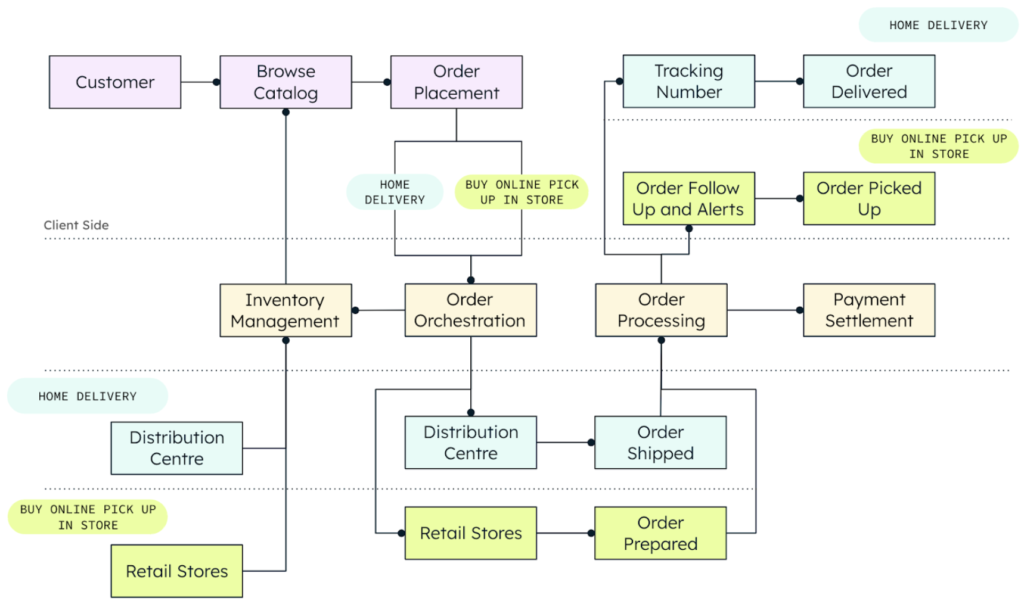Today’s customers expect a seamless shopping experience across both online and physical channels. The ability to Buy Online, Pick Up in Store (BOPIS)—or to receive deliveries at home—has become essential for meeting modern demands and staying competitive.
BOPIS has surged around 40% since the start of the pandemic, according to McKinsey & Company, resulting in logistical savings for retailers. It also enables retailers to sell additional products and services in-store. What’s more, a study by Bain & Company shows that over 80% of shoppers who plan to use BOPIS expect to shop for additional items while picking up their online orders. As a result, retailers face the challenge of ensuring real-time inventory visibility, quick order fulfillment, and reliable delivery—all while managing data from multiple sources.
With the right omnichannel ordering strategy, retailers can unify these touchpoints to offer customers a personalized and efficient shopping experience across all channels.
The challenge of omnichannel ordering
Omnichannel ordering bridges online and in-store interactions to create a smooth, unified journey for customers. However, many retailers are still working with outdated, disconnected systems that limit the customer experience. Today a customer may browse an item online only to find it unavailable in-store, or to face delays in delivery without tracking options. An effective omnichannel ordering experience would eliminate these inconveniences. A 2024 study by Uniform Market shows that around 73% of retail shoppers now interact with multiple channels, and companies that implement omnichannel solutions see revenue growth between 5 and 15 percent and improvements in cost to serve efficiencies of 3 to 7 percent, according to a 2023 paper by McKinsey & Company.
So what’s holding retailers back from implementing an omnichannel solution? Much of it boils down to outdated infrastructure. In many cases, order data is spread across legacy systems, fragmented between point-of-sale software, ERP, and inventory management systems—which probably weren’t designed to work together seamlessly.
These systems are often off-the-shelf, and lack the flexibility needed for modern integrations, meaning essential features like BOPIS or home delivery tracking can’t be supported without costly, time-consuming modifications. Often running on relational databases, legacy systems use rigid schemas that struggle to accommodate the dynamic, varied nature of omnichannel order data. Consequently, data silos prevent real-time inventory updates and cross-channel access, which are essential to an omnichannel strategy.
Retailers increasingly recognize that building an omnichannel solution in-house with a modern database enables the flexibility and scalability they need to stay competitive. Not only does this improve control over the customer journey, but it also allows retailers to customize features tailored to their unique business needs. Without this shift, retailers are missing out on increased sales and loyalty, as fragmented systems leave customers with delays, unavailable items, or an impersonal experience, impacting both customer retention and brand reputation.

Excelling at omnichannel ordering
A modern omnichannel ordering system integrates online and in-store channels for a seamless customer experience. Retailers are shifting to distributed, cloud-based architectures to enable real-time inventory and order tracking across all channels. They use microservices for flexibility, allowing each component (e.g., payments, inventory, shipping) to scale independently based on demand. The next natural step would include predictive analytics for demand forecasting, AI-driven personalization, and dynamic fulfillment options. This setup enables retailers to deliver faster, tailored, and frictionless shopping experiences, capitalizing on opportunities to drive customer loyalty and meet modern expectations.
With a robust omnichannel ordering solution, retailers can address key challenges efficiently:
-
Real-time inventory visibility: With accurate, real-time inventory updates across channels, retailers can prevent overselling and ensure customers have access to reliable stock information, critical for both BOPIS and delivery.
-
Scalability during peak demand: The solution needs to be able to scale to manage spikes in traffic and transactions, especially during high-demand periods like holidays, preventing system overloads and downtime. To give an example, Commercetools delivered a 100% uptime to their customers during Black Friday and Cyber Monday in 2023. MongoDB underpins the Commercetools platform with a MACH-compliant, agile data platform built for real-time data, AI integration, rich product search, discovery, and other essential commerce and general features.
-
Unified order management: Centralizing order data across all channels (online and in-store) enables retailers to manage and track orders seamlessly from a single platform, reducing errors and improving efficiency.
Streamlined data management: Its schema flexibility adapts to changing data requirements without costly reconfigurations, making it easier to adjust to new sales channels or service offerings. -
Enhanced order tracking: Real-time processing supports end-to-end order tracking, keeping customers updated from purchase to fulfillment, which is crucial for delivery scenarios.
-
Data privacy & security: Built-in security features, like encryption during all of the data lifecycle and access control, ensuring sensitive customer data is protected.
How to begin
Retailers can start with omnichannel ordering using MongoDB by first identifying key customer journeys, such as BOPIS and online deliveries. With these in mind, they can set up a central data platform, ensuring real-time data sync across inventory and customer touchpoints. Next, integrating with existing e-commerce, CRM, and ERP systems allows retailers to centralize and manage data seamlessly. MongoDB’s flexible schema makes it easy to unify diverse data types, such as order histories and location-specific inventories.
Order data is especially well-suited to MongoDB’s flexible document model because it often includes a variety of attributes that can change over time, such as product details, customer information, shipping options, and order status. With MongoDB, each order can be stored as a document, accommodating diverse fields and structures within the same database, making it easy to capture complex, nested data like item lists or personalized customer notes. Additionally, MongoDB’s schema flexibility allows retailers to add new fields, such as promotional codes or special instructions, without costly migrations or downtime. This adaptability makes it ideal for evolving order data requirements, ensuring scalability and smooth integration across different sales channels.
Retailers can accelerate omnichannel ordering development with MongoDB by using its flexible document model. MongoDB’s seamless API integration connects inventory, customer, and order data across platforms, creating a unified experience. Additionally, MongoDB Atlas automates key tasks like scaling, allowing developers to focus on core features instead of infrastructure. With real-time data capabilities, retailers can quickly track and adjust order flows, enhancing the solution’s responsiveness to customer needs.

What can you gain by using MongoDB Atlas?
Implementing omnichannel ordering with MongoDB offers retailers significant value by enhancing both customer experience and operational efficiency.
-
With real-time data synchronization, customers can see accurate inventory availability, making BOPIS and home delivery smoother and more reliable than ever before.
-
MongoDB’s scalability means retailers can handle peak shopping periods without compromising performance, ensuring seamless transactions even during high demand.
-
Additionally, MongoDB’s flexible, cloud-based architecture allows retailers to adapt quickly to new trends or channels, fostering innovation and helping them stay competitive in a fast-evolving market.
-
With advantages like Real-Time Order Tracking MongoDB’s distributed architecture supports live order updates, helping retailers keep customers informed from purchase to delivery, enhancing satisfaction, and reducing support inquiries.
-
With MongoDB’s flexible schema, retailers can leverage order history data and preferences to deliver personalized recommendations and tailored promotions, increasing customer loyalty and repeat purchases.
Ready to take a step into the omnichannel ordering world?
Today, a robust omnichannel ordering system is no longer a luxury—it’s a necessity. By using MongoDB Atlas, retailers can ensure real-time inventory accuracy, scale effortlessly during peak times, and unify order data from multiple touchpoints and systems. Whether it’s enabling the convenience of BOPIS or the flexibility of online deliveries, the solution’s distributed, agile database solution empowers retailers to meet and exceed customer expectations. As consumer behaviors and expectations continue to evolve, retailers leveraging MongoDB are well-positioned to adapt quickly, drive customer satisfaction, and stay ahead of the curve in a fast-paced market. Embracing MongoDB for omnichannel is a powerful step toward building a connected, efficient, and customer-centric retail experience.
MongoDB’s agile data platform helps retailers manage complex omnichannel demands, improving both operational efficiency and customer satisfaction.
Ready to transform your retail operations with a modern omnichannel solution? Discover how MongoDB Atlas can help you deliver seamless customer experiences across all channels.
Source: Read More



